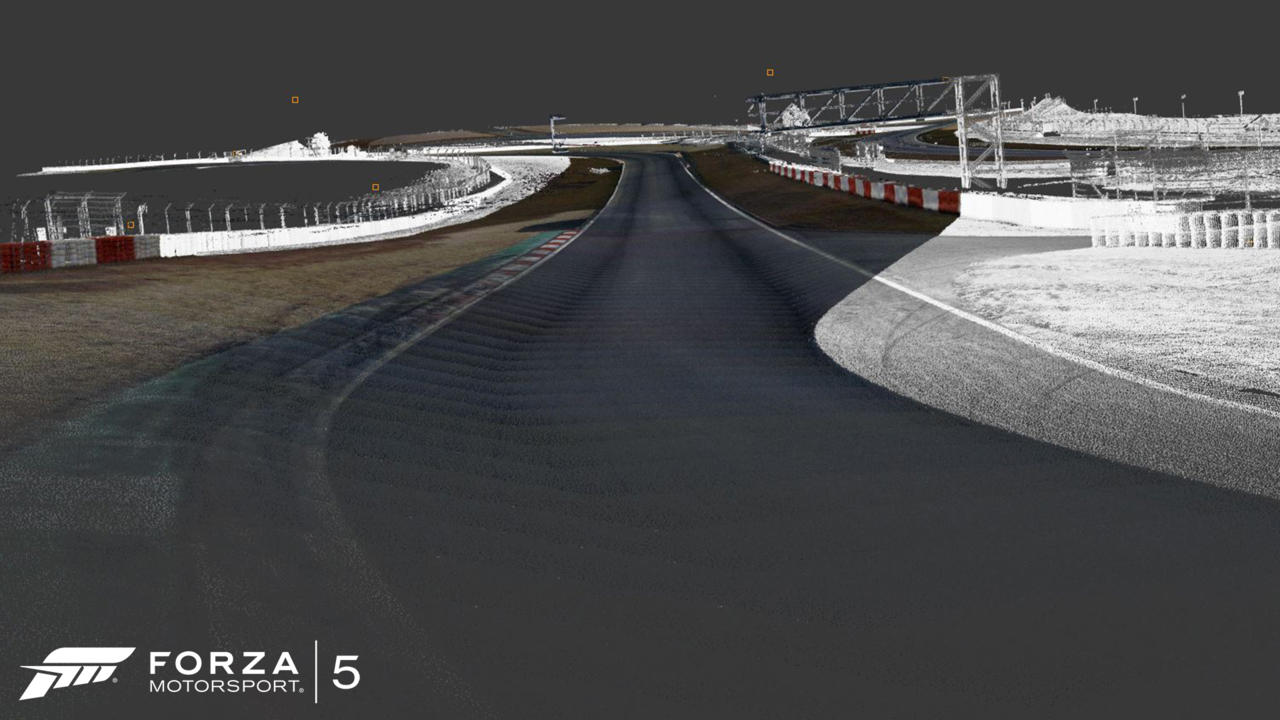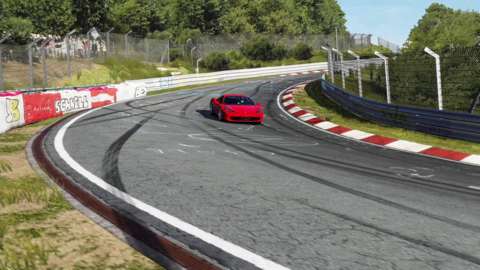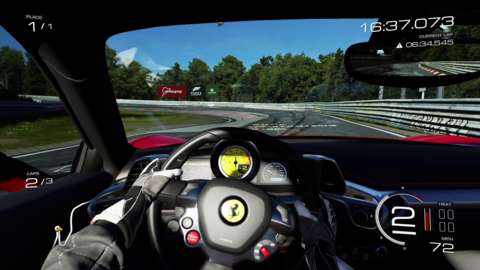Trevor Johnson is telling me a story about the history of dental technology as I try to decipher a cluster of dots on his monitor. "This type of scanning started with dentists who needed to re-create crowns for people's teeth," says the environment art lead on Forza Motorsport 5. "They needed really fine detail for scanning surfaces, and that evolved into the survey scanning technology that we rely on today."
That's when he zooms out, and the confusing cluster of dots suddenly becomes 16 miles of winding German asphalt known as the Nürburgring.
Tucked away in the dense wilderness of the Eifel Mountains some 43 miles south of Cologne, the Nürburgring is one of the most iconic racing venues in all of motorsport. It's most famous for the Nordschleife, or north loop, a dizzying, 13-mile tangle of graffiti-covered roadway weathered by over 80 years of winter frosts and public access. It's also familiar to Formula One fans for the shorter, more modern Grand Prix section introduced in 1984 as a response to growing safety concerns over the track's antiquated predecessor.
Despite its history and status as one of the most famous racing destinations in the world, the Nürburgring was a no-show when Forza 5 launched this past November. It was a conspicuous absence when you consider that the German raceway has been present in Forza Motorsport in one form or another since the series debuted in 2005.
So why did the Nürburgring miss the initial launch of Forza 5? And why is it being released now--as a free download, no less--nearly seven months later? To understand that, you need to understand the new technology that inspired Turn 10 to rebuild all of its tracks from scratch, and why the lingering effects of that decision have led the studio to give back to its fans in a way it never has before.
Nancy Drew: Mystery of the Seven Keys | World Premiere Official Trailer Modern Warfare III & Warzone - Official Cheech & Chong Bundle Gameplay Trailer The Fallout TV Show's Biggest Easter Eggs Teenage Mutant Ninja Turtles: Splintered Fate – Announcement Gameplay Trailer Dead Island 2 – Official SoLA Expansion Gameplay Launch Trailer Little Kitty, Big City – Release Date Reveal Harold Halibut GameSpot Video Review SteamWorld Heist II – Official Reveal Gameplay Trailer Cat Quest III - Release Date Trailer LORELEI AND THE LASER EYES | Release Date Trailer Honkai: Star Rail — "Non-Zero-Sum Game" | A Moment Among the Stars Animated Trailer Stellar Blade - Official Live Action Release Date Trailer| PS5
Please enter your date of birth to view this video
By clicking 'enter', you agree to GameSpot's
Terms of Use and Privacy Policy
Getting to the point
Those dots on Trevor Johnson's screen may look like a bit of Seurat-esque pointillism, but they're actually called point cloud data. This information is the product of the new laser-scanning system that Turn 10 began using for all of Forza 5's real-world tracks. Imagine a giant contraption that sends a laser blast out in every direction, returning detailed information on surrounding surfaces in terms of both physical space and RGB color values. Spend enough time lugging that thing around a track, and what you get is a comprehensive 3D model of an entire circuit, one that consists of a seemingly infinite number of tiny dots that tell you everything from the severity of a pothole to the darkened coloring of a freshly patched stretch of asphalt.
"It wasn't until recently that the level of fidelity we needed has come to be with this technology," says content director John Wendl. "Laser scanning has been around for a while, but it just lacked the quality we needed to get usable information. Now with point cloud data, we get geometry information, but we also get texture and lighting information as well."
Tucked away in the dense wilderness of the Eifel Mountains some 43 miles south of Cologne, the Nürburgring is one of the most iconic racing venues in all of motorsport.
It's a far cry from the method that Turn 10 employed on previous games, which involved studying satellite imagery to get a feel for a track's layout. Because that top-down approach naturally misses many of a track's subtle topographical shifts--the slope of a hill, the bank of a curve--the artists would then have to rely on track photography and manual measurements to determine those surface details. It was an approach that required a great deal of visual interpretation, something that never quite sat right at a development studio so obsessed with realism.
"Before Forza 5, we used to use a military-grade GPS system," explains Wendl. "And those systems, while they're very accurate on the horizontal scale, they're fairly bad on the vertical scale."
"So we had to use photos and measurements to gauge vertical variety," says Wendl. "And on a track like this with all kinds of dips and undulations, this thing is just ancient. All that comes through on our new system with millimeter accuracy."
Johnson is a little more blunt about the benefits of laser scanning. "We can't memorize everything," he says. "We don't want to allow ourselves the chance to make assumptions."
But as accurate as that point cloud data is at telling the story of a track's wear and tear, all those little dots hardly make for a playable game environment. It takes a team of artists like Johnson to study that pool of information and turn it into a drivable environment complete with lighting, textures, and 16 miles' worth of dense German forest.

Coloring in the details
Scanning for point cloud data is one step in Turn 10's track creation process, but it's not the only one. Think of it as the foundation. Once it has that baseline of track information, that's when the art team can begin layering in the aesthetic details that make up each circuit's visual identity. And for that, the artists need to pore over terabytes of photo and video reference material.
Imagine a sleek Ferrari 458 Italia tearing through the Nordschleife, an elegant yet aggressive testament to modern automotive design. Now imagine the opposite: a car affixed with so many cameras you can hardly tell what model it is beneath those gangly appendages. Atop the roof sits a Ladybug camera for capturing a full 360-degree panorama, while elsewhere on the exterior reside a handful of GoPros for grabbing all the other random angles. Think of it as the mutated cousin of the Google Street View car.
It's not pretty, but it's functional. Driving these video wagons around is what helps Turn 10 capture the overall flow of a track: the way all those trees zipping by establish a certain sense of speed, or the way distant vistas rise up from the horizon when you're cresting a hill. They're those little touches you can feel only when you're in motion, something that becomes all the more critical when you're talking about a circuit like the Nordschleife, whose 154 turns all provide slightly different sightlines into the German wilderness.
Then there's the on-site photography, largely used as reference material for re-creating surface textures around the track. These photos are what tell the artists back in the studio what shade of red is used in a rumble strip, or how brown the newly exposed soil is where they recently tore up a disused stretch of the GP circuit.
The art team tends to be a little obsessive about these details.
"You'd be surprised how many different levels of gravel color there are between Nürburgring and Catalunya," says Johnson. "The color of the earth, where the rock is quarried--it's always going to be a little bit different."

That attention to detail has only grown more obsessive with Forza 5. In every single research photo from around the track, whether it's a bit of graffiti on the ground or trees in the distance, you'll find a small object decorated with various swatches of color hidden somewhere in the frame--what Wendl describes as Turn 10's own personal version of a Where's Waldo? drawing. That object looks a bit like a makeup palette, but it's actually a color chart--a tool used to compensate for different exposure levels and lighting conditions.
Taking all these photos and tweaking them so that every shot shows the same exact shades of color in that chart is part of Turn 10's exhaustive color-correcting process, a critical step before those colors can be integrated into the game as textures. It's a process that Turn 10 never had to worry about on previous games, but it's become a necessary evil on the Xbox One.
For that, we can thank new visual effects like the high-dynamic range lighting that makes emerging from a dark tunnel so blinding, or the simulated gloss that makes the wooden dash of a Lotus Elan look so classy. In short, lighting is far more variable in Forza 5 compared to its predecessors, with color values that are constantly shifting as you move around the track and artists who are always playing around with the way surface materials respond to light. According to Wendl, the slightest difference between two shades of red might lead to one pleasantly vibrant hue and one nuclear explosion of crimson when certain lighting conditions are applied. The artists at Turn 10 could fudge those details on older games, but modern lighting effects are less forgiving.
"In the past, it was a highly unpredictable system. It took an artist who knew our system inside and out with all its little idiosyncrasies," Wendl explains. "That worked until different parts of the same world were tuned differently. You'd turn this dial over here, and something weird would happen over there. So now we've been able to level that, and we can really push those effects."

Saying thank you
The Nürburgring is something of an anomaly in the racing world. So much of what has made it famous--its length, its unforgiving layout, its weathered asphalt--is also what many drivers despise about it. It's a demanding track, that much is certain. And its demands don't end at driving the thing.
"The time we put into Nürburgring is worth probably four or five regular tracks," says Wendl. "From a sheer production perspective, it takes forever. We had over 30 artists working on it for 13,000 man-hours. It's just an incredible effort to build this thing."
But as time-intensive as it was to go back to the drawing board on the Nürburgring, it's been a rewarding process for the artists at Turn 10. "No other track has this kind of character," says Johnson. "That's what's fun about it for us, is trying to re-create that. It feels very artistic and expressive."
We had over 30 artists working on it for 13,000 man-hours. It's just an incredible effort to build this thing.
John Wendl
Sure, that means placing 26,000 trees by hand and going through 13 miles' worth of Nordschleife graffiti to clean up any German swear words or bits of human anatomy painted on the track. But one look at the newly constructed version of the Nürburgring, and you see how much that effort has paid off. There's that visual storytelling in the way a set of skid marks lead straight into a banged-up guardrail, a reminder that anyone with €27 can drive the Ring on public days, but not everyone with €27 probably should. There's the warm light cascading through the trees and over distant hilltops that makes Forza 4's gray and foggy version of the Nordschleife feel downright postapocalyptic. All those little touches add up to transport you straight to the Eifel Mountains, ready to challenge a track that just goes on and on and on.
But the changes are more than cosmetic. For the first time in the series, Turn 10 has been able to combine the Nordschleife and the GP circuit into one continuous 16-mile configuration to make an already intimidating track that much more daunting--something it could never quite pull off on the Xbox 360.
"With our streaming system on the Xbox 360, we tried. It broke our system," explains Wendl. "We could have stripped a lot of things out to make the whole ribbon fit, but not to the level of detail that we wanted to do it."
Of course, all of those improvements added up don't remove the sting of Forza 5's initial launch. Despite a litany of improvements to the overall driving experience, Turn 10's commitment to rebuilding all of its tracks for the Xbox One led to a drastically reduced amount of content--something that the studio's reminded it of every opportunity they could get. And while research work began on this new version of Nürburgring before Forza 5 shipped, eventually the team had to accept that it would need to be released farther down the line.

"There was just a time during production on Forza 5 when we said, 'You know what? The time has come for the disc to set sail,'" explains Wendl. "But that engine never shut down. At some point, we just had to put a stamp on the disc and send it out there."
At that point, it very much became a case of "you don't know what you've got until it's gone." The Forza community came out in droves, letting Turn 10 know that the Nürburgring should--nay, must--return to the franchise.
"In many ways, Nürburgring wasn't that highly requested until it wasn't there," says Wendl. "It kind of depends on how you ask people. When Nürburgring was in Forza 4, Bathurst and Spa were the most requested. Then we shipped those tracks, and when Nürburgring wasn't there...believe me, we wanted to make it to launch."
And so, taking stock of the post-release climate, Turn 10 made the decision to release its first downloadable track, Road America, as a free update--something it continued in April with Long Beach, and will continue when the Nürburgring launches as a free update today. It's the studio's implicit way of saying thanks for being patient while it continues the series' transition toward a new generation of console hardware.
"It just seemed like the right thing to do to give them away," says Wendl. "We just want to thank people for playing the game."